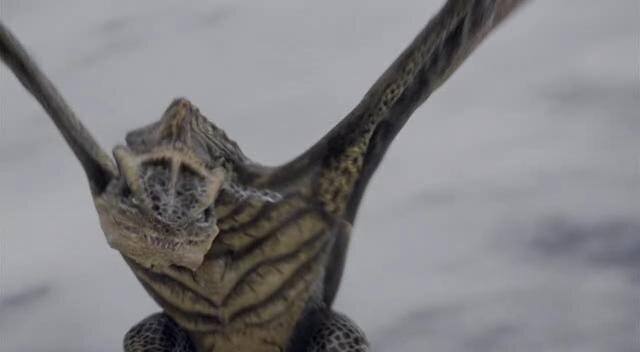Wyvern

These creatures are huge mutated lizards that have an uncanny appearance to the mythological Wyvern. They are massive creatures, with a wingspan of nearly 40’ in length and a body that is around 10’ from end to end, not including the long tail. They are very heavy, weighing in excess of 500 pounds and are very powerful.
Chris Van Deelen is the author of the Skirmisher Publishing LLC sourcebook Creatures of the Tropical Wastes sourcebook, co-author of its Wisdom from the Wastelands game supplement and contributor to the 'Sword of Kos: Hekaton' Anthology.
No. Enc: 1 (2d4)
Alignment: Neutral
Movement: 90’ (30’)
210’ (70’) Fly
AC: 0
HD: 18
Attacks: 1 or 2 (bite or claw, claw)
Damage: 2d6 (plus special) or 1d12+3 / 1d12+3
Save: L18
Morale: 10
Hoard Class: None
These creatures are huge mutated lizards that have an uncanny appearance to the mythological Wyvern. They are massive creatures, with a wingspan of nearly 40’ in length and a body that is around 10’ from end to end, not including the long tail. They are very heavy, weighing in excess of 500 pounds and are very powerful.
The creatures have incredibly tough hides that are impervious to most piercing weapons (they have a damage resistance of 6 against piercing weapons) and are still very tough to penetrate with many other weapons, even energy weapons have been known to simply bounce off or be reflected by the scales on their hide.
These creatures are purely asexual. Every creature is capable of producing a clutch of 2d4 eggs once every 12 months. The creatures lay the eggs high up in hills, mountains or even on the tops of large still standing ruins.
Before laying the eggs, the creatures spend time hunting prey, which they kill and then store near the nest where they will lay the eggs. They do this because that they will not leave the eggs for any reason. The parent guards the eggs the entire time; until they hatch. It takes only 3 months for the eggs to mature and once they hatch, the young grow to maturity in another 3 months, at which time they are capable of surviving on their own.
These mutants are pure carrion eaters. They will attack living creatures simply to kill them and they will let the food rot. The riper the meat, the better they like it. The worst part is the bite. These creatures are carriers of a mutated version of the flesh eating bacteria. This disease acts in all manner like the un-mutated version, including the eventual death of the affected creature. The difference is that once the creature has died and begins to rot, it never fully decays, staying at a level of putrification that is about 3 weeks advanced. It is a symbiotic relationship with the mutant and suits the creature just fine.
In combat, the mutant always attacks with its bite first, and any creature that is bitten must save versus poison or contract the disease. It will then use its two hind claws to attack, causing horrible rending damage to the target.
Because of the nature of the beast, whenever it is found that a creature has taken up residence in the territory controlled by a humanoid tribe, they do what they can to track down and destroy the creature. They are deadly hunters and can easily decimate the local wildlife and population if left unchecked. Often, killing one of these mutants is a costly proposition, but the tribes have little choice but to risk it.
It has been tried, but so far no tribe has been able to take a young creature and domesticate it. The young always turn on the would-be domesticators with typically tragic results.
Mutations: Aberrant form (natural weapons), asexual (special), carrier (flesh eating bacteria), complete wing development, dietary requirement change (carrion), natural armour.
Source: Wyvern



